In the decade prior to its demise in 1991, Pearson Yachts was noted for building mainstream cruiser/racers of above average construction with decent sailing and cruising characteristics.
During its long history, Pearson’s boats can be divided into three fairly distinct categories. Though the company was formed in 1956, its first large successful sailboat was the Triton, in 1959. Into the mid-1960s, Pearson built solid boats, like the Vanguard, Rhodes 41, Invicta 38 and Countess 44, that were capable of offshore sailing. This was due in part to their moderately heavy displacement, full keels and all-wood interiors, which allowed bulkheads to be tabbed to the deck, as well as all furniture to the hull.
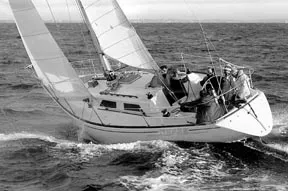
As the demand for lighter, general-purpose boats became stronger, and as Bill Shaw took over all the design work, Pearson built a lot of CCA-type full-keel sailboats, including the Pearson 33 and 39. Some were keel/centerboards. They had large mainsails, smaller foretriangles, and generous overhangs. These boats represent something of a transition between the old Rhodes, Alberg and Alden designs, and Shaw’s 1980-era designs, which make up the third category.
The Pearson 37 is one of several transitional Bill Shaw designs that stands apart from the others.
The Pearson 37 was designed to meet the IOR rule, and double as a family cruiser. It was the start of the racer-cruiser era, and the Pearson 37, launched in 1981, was a model for this period. Production totaled 42 boats and lasted only a few years. It is not to be confused with another Pearson 37 that was aimed specifically at the cruising market and manufactured from 1987-89. The re-designed hull shape of the second 37, the 37-2, is more conventional, with a greater 12′ 4″ beam, and there moderately priced examples currently on the used market. (See the accompanying Market Scans.)
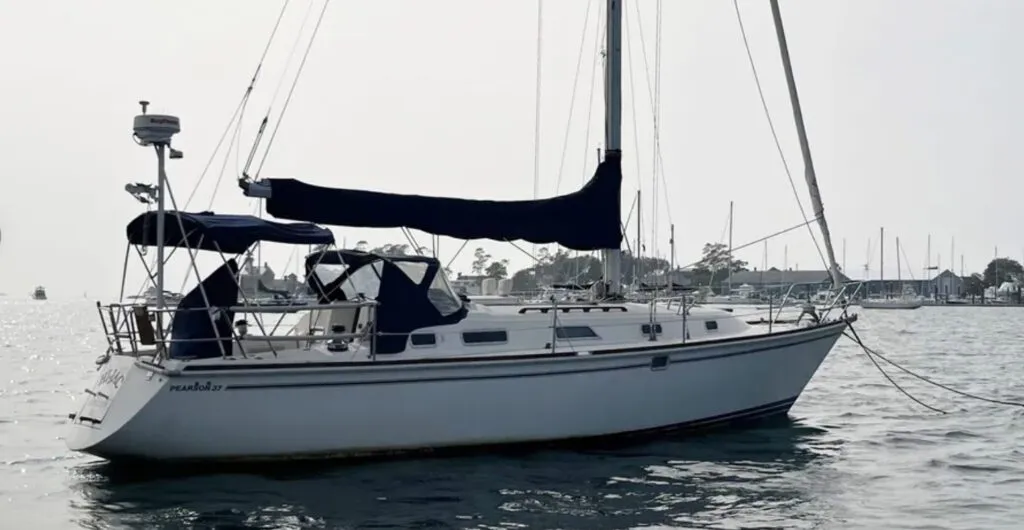
“That later boat was designed specifically for the cruiser who wanted to tie up his boat in the marina at night,” said Shaw. “We built a powerboat-like interior with a double berth forward, and placed two swivel chairs in the saloon. We were on the cutting edge of what is now considered a typical sailboat interior. We also added a stepa-board transom.” The so-called “sugar scoop” was born.
The 6′ 6″ deep fin of the 1981 boat was replaced with a 4’ 8″ shoal draft keel for gunkholers, and winglets were added, which some owners say slightly improved its pointing ability.
Other cruising additions were a self-tacking jib, lazy jacks, and a mainsail with a built-in sail cover that zipped over the boom à la the Doyle Stack Pack.
Design
The earlier Pearson 37 was one of 43 boats Bill Shaw designed during his 27-plus year tenure at Pearson Yachts, first as designer, later as general manager and part owner.
“I designed the boat for sailors who wanted to race their boats in IOR and PHRF fleets, then jettison the crew, pick up the wife and children, and go cruising,” he said. “The hull design was state-of-the-art, if you will, and she was furnished with a comfortable, though lightweight, interior.”
The IOR influence is evident in the pinched ends and bustle.
The boat carries plenty of sail for its intended purpose; the high-aspect mainsail measures 276 sq. ft. and the foretriangle 363 sq. ft. for a total of 639 sq. ft. This give the boat a sail area/displacement ratio of 18.7. The spinnaker is 1,302 sq. ft.
Displacing 12,800 lbs. on a waterline of 30′ 1-1/2″, the 37’s displacement/length ratio is 195. This is not light by today’s standards, but light to moderate for its time.
The rudder is behind a small skeg and there are flaps to minimize drag. All through-hulls are flush.
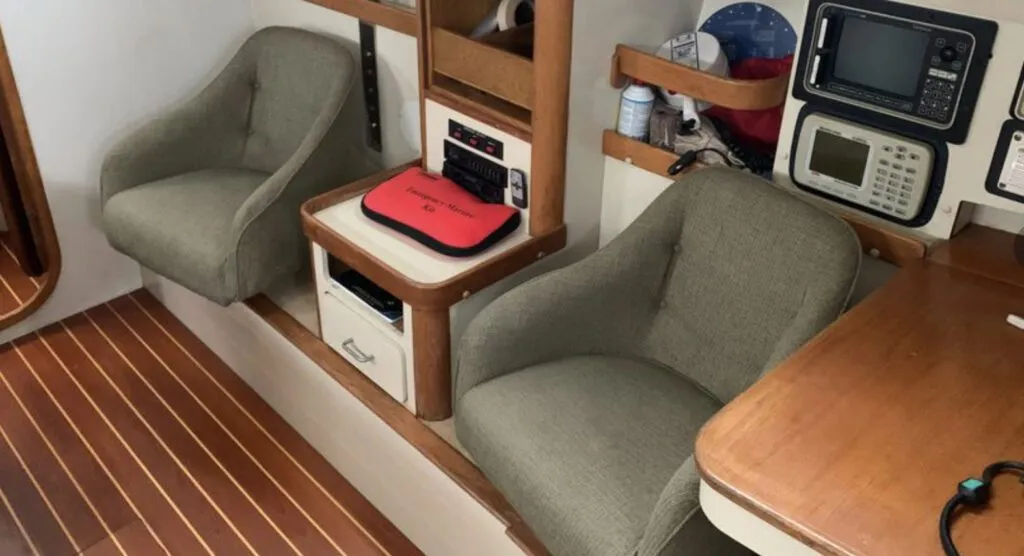
Accommodations are significantly more comfortable than today’s modern race boat. The hulls are lined with spruce and hickory, cabin soles are teak and holly, and the head and master stateroom are enclosed with wooden doors. There are berths for seven, which you might fill on an overnight race, but that’s too many for cruising.
Construction
In typical Pearson fashion, the early 37’s construction schedule and hardware have conservative specifications.
“Our approach was to evaluate loads and then build in a 30-percent fudge factor,” Shaw said.
The lamination schedule for the balsa-cored hull included alternating layers of mat and roving, “to provide impact resistance,” Shaw said. The deck is cored with balsa. Encapsulated plywood was substituted in areas where hardware fastens.
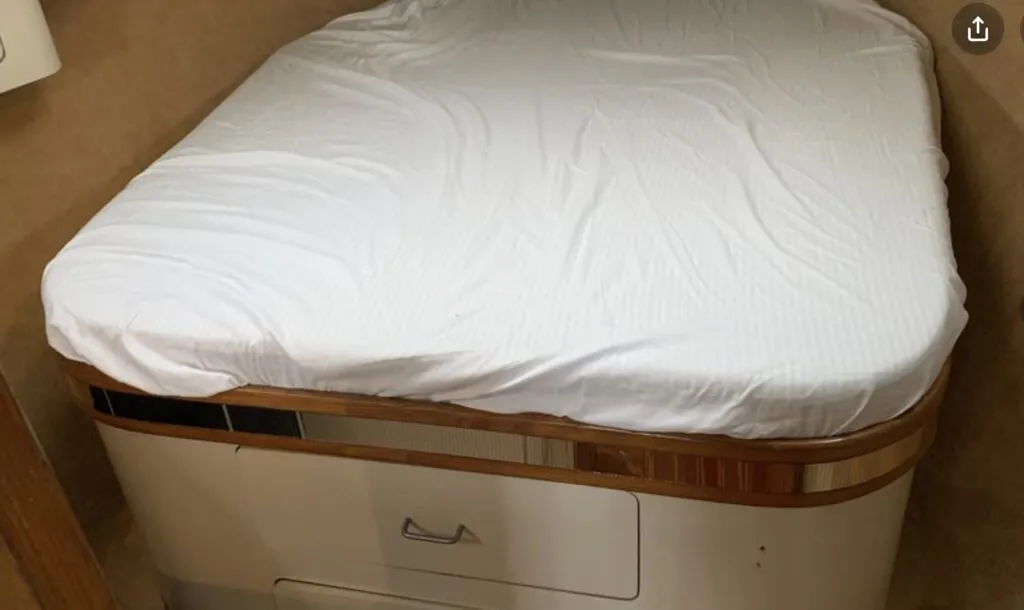
Though vinylester resins were not being produced at the time, Shaw says that the company had overcome blistering problems by using high quality gelcoat. However, several owners report minor blistering on their hulls.
“We noticed reoccurrences of blistering following the energy crisis of the late 1970s,” Shaw said. “Gelcoat was turning yellow, and we saw evidence of crazing. My theory is that the manufacturer was substituting ingredients in the product because of the oil crisis. We also determined that boats in northern climes that were hauled every winter were less prone to blistering, especially compared to those in the south that lived in warm, brackish water.”
The hull has an inward-oriented flange onto which the deck was laid. It was bonded with silicone, the seam was glassed on the underside of the deck, and stainless steel fasteners were bolted through the teak toerail.
In response to owner comments regarding leaky portlights, Shaw said, “We used the best materials available at the time, but silicone will eventually cause leaks.”
Wiring runs are accessible; wires are bundled and color coded, and owners report no electrical problems or failures.
Water is in two 35-gallon bladder tanks below a settee. The aluminum fuel tank holds 22-gallons.
Deck
The keel-stepped mast is tapered with double spreaders. The upper, intermediate and lower shrouds are #8, #10 and #12 Navtec rod, and stays are #10 rod. There also is a babystay that fastens to a short track on deck.
Our test boat, which was commissioned in 1981, wears its age well. The gelcoat is smooth and fair, and shows few signs of crazing; the diamond nonskid was effective during rainy test conditions. Double lifelines running from bow to stern, coupled with a 2″ teak toerail and cabintop handrails, provide security when heeled.
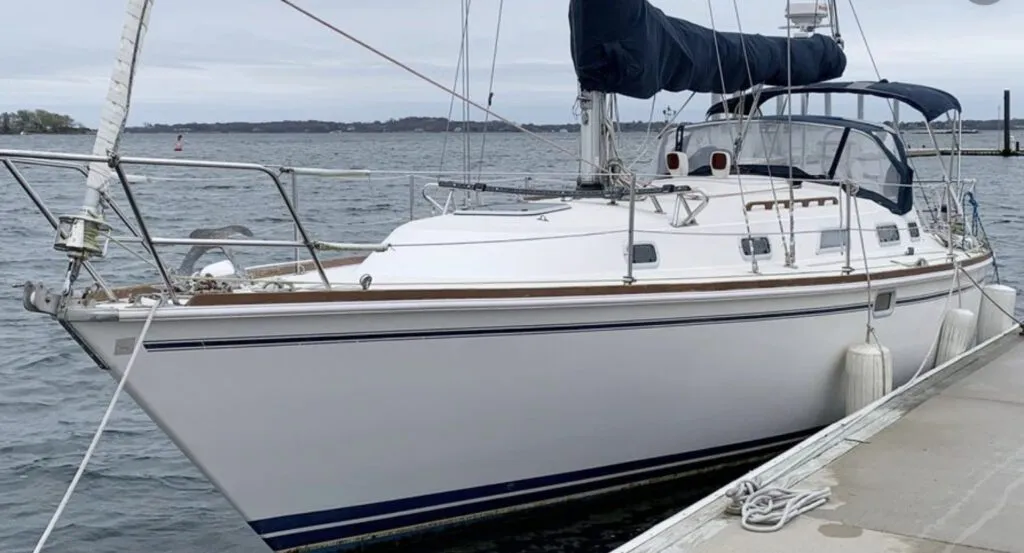
Halyards are inside the mast, a bit unusual on boats of this vintage. They run through turning blocks attached to the mast collar to four two-speed Lewmar 42 winches mounted on deck just aft of the mast. For windward work, when tight sheeting angles are required, the jib sheets are led aft through two cars on tracks located inboard next to the cabintop. For sailing downwind, they can be re-led to tracks on the toerail. The primary winches are three-speed Lewmar 48s.
Flattener, reef lines and other sail controls are led to two-speed Lewmar 30s mounted atop the coachroof within easy reach of the trimmer; standard equipment was four stainless steel cleats that we would replace with modern rope clutches.
The boat is well ventilated by two hatches, one 26″ square over the forepeak and a second, 12″ square, over the head.
The cockpit measures 8′ 6″ and seats 6-8 adults on comfortably contoured seats. In fact, Shaw probably designed the most ergonomic cockpit seats of any designer doing production boats. The helmsman sits atop a rounded seat while under power, then moves to seats in the cockpit corners for sightlines to the telltales.
A port lazarette with a 40″-wide opening is a 6′ long, 36″ deep locker large enough to hold a deflated inflatable dinghy; otherwise, it would benefit from installation of a shelf. Stowage for two propane tanks is located to port at the transom.
Boats came with a 40″ stainless steel destroyer wheel with less than two turns lock to lock.
The mainsheet tackle is near the end of the boom and connects to a traveler on the bridgedeck. This location makes moving in and out of the cabin somewhat inconvenient, but seems best for proper sail control. The only alternative would be mid-boom sheeting to a traveler mounted on a bridge over the companionway, but this would be less convenient for the trimmer and require more purchase.
Interior
Exploration of spaces belowdecks confirms that Shaw does not exaggerate the boat’s dual personality. The interior is well-lighted by portlights. Spruce and hickory line the hull and overhead. The hickory dining table stows flush against the bulkhead, which opens the area to traffic and makes way for moving through with sails for packing under the V-berth. Headroom is 6′ 3″. Several owners commented that adhesives holding interior wood panels eventually loosened.
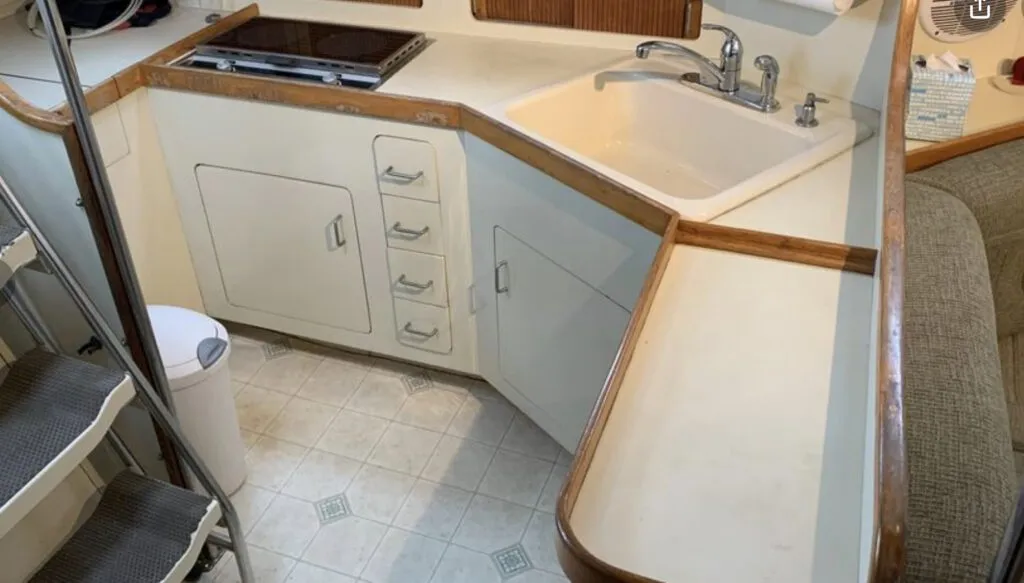
The L-shaped galley is located to port below the companionway, which facilitates ventilation of odors and the transportation of vittles to the cockpit. It centers around a gimbaled propane stove, though many boats were retrofitted with electric ranges that either drew rave reviews (“much safer and don’t have to worry about an explosion,” one owner said) or were ridiculed.
Storage is in two large dry lockers and shelves that surround the stove. A well-insulated 33″ x 30″ icebox aft of the stove reportedly will maintain block ice for up to five days. The stainless steel sink is forward in a leg of the galley that separates it from the saloon.
Opposite the galley is the nav station with a 24″ x 36″ table that’s actually large enough to be functional; its storage area, however, is only 4″ deep.
The electrical panel is mounted outboard in a fascia that has enough room for electronics such as VHF radio, GPS, stereo and other instrumentation. To work at the chart table, one sits on the head of the quarterberth, so there is no backrest.
This quarterberth is 48″ wide at the head, 6′ 6″ long, and furnished with a reading light and shelving.
Additional sleeping accommodations are in port and starboard settees and pilot berths, which measure 26″ wide and 77″ long. The pilot berths are equipped with canvas lee cloths, and are more comfortable for sleeping than the settees.

The master stateroom in the bow is enclosed by a wooden door, and has 6′ standing headroom. The V-berth is 5′ 11″ wide at the head and 6′ 6″ long. The compartment has two hanging lockers and additional storage below the berth, which also houses the holding tank.
The head, located to starboard, measures 41″ long and 38″ wide, and is equipped with a canvas-lined clothes hamper—a nice touch. Furnishings include a stainless steel sink, a functional medicine cabinet, and linen closet behind the vanity.
Considering its racing orientation, we think the boat’s layout, accommodations, and volume of storage areas are adequate for coastal cruising.
Performance
Most owners who race their Pearson 37s report that the PHRF rating is around 105-108, depending upon spinnaker size, but we found boats with ratings as low as 99. The owner of our test boat races year round in the Pacific Northwest and typically finishes among the first three boats in a fleet of 35- to 55-foot racer/cruisers. He is flying older Dacron sails, so we would anticipate significant improvements in boat speed and pointing ability if outfitted with newer sails.
We tested the boat on a raw winter day in wind speeds ranging from 12-25 knots and a 2′-3′ chop. The owner typically loads the hydraulic backstay adjuster to 2,500 pounds for sailing to weather in these conditions.
Sailing with a 130% jib and full mainsail, boat speed was 6.7 to 7.4 knots on a close reach, about a half knot slower when hard on the breeze. With properly trimmed sails the helm is well-balanced; easing the main traveler to leeward in heavy puffs dramatically reduced weather helm. We depowered the main by increasing backstay tension.
On a weather beat the boat pointed to within 30°-35° of apparent wind, and tacked through 80°-85°; it tends to go sideways when heeled more than 15°.
In the heaviest puffs we noted rudder stall when attempting to foot off. Shaw says this is the product of a design intended to meet then-current IOR design targets.
“The best solution in those conditions is to have a mainsail trimmer who can ease the sheet,” he advised.
The owner of our test boat reported speeds of 9-11 knots sailing under spinnaker, and 8.5 knots downwind with the #2 jib poled out while towing a dinghy.
The strong suit of IOR designs is sailing upwind. When reaching and running, these boats are more difficult to handle and the Pearson 37 is no exception.
Our test boat was equipped with a Universal 3-cylinder diesel rated at 23-hp. equipped with a Martec folding propeller. It motored at 6.2 knots at three-quarters throttle, backed up easily and tracked well in reverse.
Because there is no insulation under the cockpit sole, it’s noisy underway; one owner attacked the situation with heavy insulation and reportedly reduced engine noise belowdecks to 62 db.
Conclusion
The overall condition of our test boat was impressive, especially considering that it lives year round on a mooring in the Pacific Northwest and is sailed hard by its original owner. Though he doesn’t spend weekends polishing the hull or varnishing the woodwork, the boat shows only the signs of wear we’d expect to see in a boat of a certain vintage.
Also impressive was its performance. The Pearson 37 rates only 15-20 seconds slower than newer, similarly sized boats, and has decent cruising amenities. We’d opt for the deep keel, if it can be sailed in your local waters.





























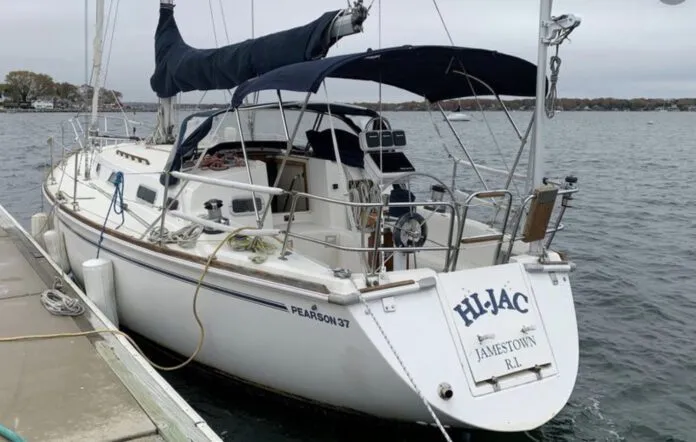





I would like to see more write ups on the Pearson 39-2